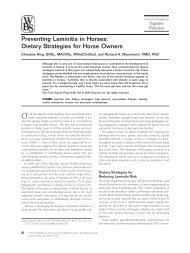Nutritional Secondary Hyperparathyroidism in the Horse
Nutritional Secondary Hyperparathyroidism in the Horse
Nutritional Secondary Hyperparathyroidism in the Horse
Create successful ePaper yourself
Turn your PDF publications into a flip-book with our unique Google optimized e-Paper software.
Cl<strong>in</strong>ical Pathology 37<br />
Table X. Serum calcium and phosphorus <strong>in</strong> spontaneous nutritional secondary<br />
hyperparathyroidism <strong>in</strong> <strong>the</strong> horse (KINTNER<br />
and HOLT)<br />
Calcium Phosphorus<br />
mg./100 ml. mg./100ml.<br />
Normal horses, n = 96<br />
Maximum 14.3 5.00<br />
M<strong>in</strong>imum 10.2 2.63<br />
Average 11.2 3.55<br />
<strong>Horse</strong>s with nutritional<br />
secondary hyperparathyroidism, n = 36<br />
Maximum 12.7 5.87<br />
M<strong>in</strong>imum 8.1 3.20<br />
Average 10.2 4.26<br />
Samples were taken only once.<br />
KINTNER and HOLT (1932) studied a wide range of blood constituents<br />
<strong>in</strong> affected and normal horses. Differences existed only with<br />
regard to calcium and phosphorus (Table X).<br />
GROENEWALD (1937) reported that blood serum calcium, phosphorus,<br />
and alkal<strong>in</strong>e phosphatase were normal <strong>in</strong>his three experimental<br />
cases compared to two controls.<br />
No reports of a series of determ<strong>in</strong>ations of serum calcium,<br />
phosphorus, and alkal<strong>in</strong>e phosphatase made dur<strong>in</strong>g <strong>the</strong> experimentally<br />
<strong>in</strong>duced course of nutritional secondary hyperparathyroidism <strong>in</strong> <strong>the</strong><br />
horse have been found <strong>in</strong> available literature.<br />
6. Roentgenologic Changes<br />
KINTNER and HOLT (1932) used radiographs as an aid to diagnosis.<br />
Anteroposterior views of <strong>the</strong> metacarpi were taken. The progress was<br />
followed radiographically with follow-up plates taken 3 months after<br />
<strong>the</strong> <strong>in</strong>itial ones. Correlation with cl<strong>in</strong>ical symptoms was good. Cortical<br />
and medullary portions blended toge<strong>the</strong>r to give a hazy, irregular<br />
appearance to <strong>the</strong> l<strong>in</strong>e of separation. The medulla was widened at <strong>the</strong><br />
expense of <strong>the</strong> cortex. Longitud<strong>in</strong>al striations of decreased density<br />
were apparent <strong>in</strong> <strong>the</strong> cortex <strong>in</strong> vary<strong>in</strong>g degrees.<br />
GROENEWALD (1937) also radiographed <strong>the</strong> metacarpi of his<br />
experimental horses. He did this once, 2 months prior to <strong>the</strong> time<br />
severe cl<strong>in</strong>ical symptoms were noted. His f<strong>in</strong>d<strong>in</strong>gs were similar to those<br />
of KINTNER and HOLT.<br />
Downloaded from<br />
vet.sagepub.com by guest on April 14, 2010



